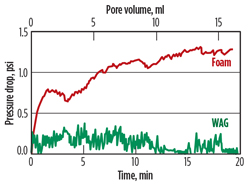Innovative thinkers
Enhanced Oil Recovery: Foam in, oil out
|
Foam has been used routinely in the oil and gas industry to recover production from gas wells that are afflicted with an increasing water cut. When surfactant sticks are dropped into a well, lower interfacial tension between the foam bubbles reduces the weight of the water column in the wellbore. It is then easier for the bottomhole pressure to push this foam column up the wellbore and, thereby, dewater the well.
Rice University researchers, led by Dr. Sibani Lisa Biswal, are conducting experiments to exploit a different property of the foam—mobility control—as an avenue for enhanced oil recovery (EOR). Lab experiments conducted by the team have revealed that foam bubbles are better able to squeeze into tight vuggy rock or microfractures and displace the hydrocarbons than water or water alternating with gas (WAG). The results of the experiments were published online by the Royal Society of Chemistry journal, Lab on a Chip. In addition to Biswal, authors of the paper are Charles A. Conn, Kun Ma and George J. Hirasaki. To conduct their experiments, the Rice research team created two microfluidic devices, one to generate the foam and another to observe the fluid transport and oil displacement phenomenon. A polymer, called PDSM, is used to create such microfluidic devices for lab experiments. Etching was performed on a silicon wafer to create a small-pore network composed of microfractures, or vuggy rock. This network was then flushed with dyed paraffin oil. The experiments consisted of injecting foam, water or WAG from one side and recovering displaced oil from the other side, while measuring the pressure gradient across the network. The team determined that the foam displaced 74.9% of oil from low-permeability regions after 4 min. of pushing it through a test rig, vs. 47% for WAG, and only 1.7% for water. The pressure drop for foam was significantly higher for foam than WAG, Fig. 1.
The less-viscous fluids appear to displace oil in high-permeability regions while blowing right by the smaller cracks that retain their treasure. But foam offers mobility control, which means a higher resistance to flow near large pores. “The foam’s lamellae (the borders between individual bubbles) add extra resistance to the flow,” said Biswal, Rice associate professor of chemical and biomolecular engineering. “Water and gas don’t have that ability, so it’s easy for them to find paths of least resistance and move straight through. Because foam acts like a more viscous fluid, it’s better able to plug high-permeability regions and penetrate into less-permeable regions.” Charles Conn, a Rice graduate student and the paper’s lead author, said foam tends to dry out, as it progresses through the model. “The bubbles don’t actually break. It’s more that the liquid drains away and leaves them behind,” he said. Drying has two effects: It slows the progress of the foam even further and allows surfactant from the lamellae to drain into low-permeability zones, where it forces oil out. Foam may also cut the sheer amount of material that may have to be sent downhole. One of the challenges will always be to get the foam to the underground formation, intact. “It’s nice to know that foam can do these things, but if you can’t generate foam in the reservoir, then it’s not going to be useful,” Conn said. “If you lose the foam, it collapses into slugs of gas and liquid. You really want foam that can regenerate as it moves through the pores.” Rice researchers are conducting the same experiments on core samples, to see how the fluid transport mechanism operates in the 3D environment of a core sample that is more analogous to a hydrocarbon reservoir. “Our experiments show at the pressure drop tends to be lower in core samples,” Dr. Biswal reported. The next step for the researchers is to find out if the rate of oil displacement can be increased with higher temperatures and pressures. Dr. Biswal said positive results have been seen in pilot studies in China, and tests are planned at a field in West Texas. In conventional oil fields, the recovery factor during the primary recovery stage is typically 5% to 15%. The recovery factor is even lower for shale or tight oil fields. Secondary recovery through water or gas injection increases the recovery factor to 25% to 35%. Thermally enhanced tertiary recovery (e.g., steam flooding) allows another 5% to 15% to be recovered. If the Rice University experiments with foam result in practical field applications to increase the recovery factor at a lower cost, then there can be significant economic value for the Rice University research. In recent years, Rice University has announced a number of research breakthroughs in the energy sector, including an advance in carbon capture technology and a nanotracer tester to study hydraulic fractures. The Rice University research into foam EOR has been supported by the U.S. Department of Energy and a consortium of Abu Dhabi energy companies and R&D agencies, including the Abu Dhabi National Oil Company. |

- Applying ultra-deep LWD resistivity technology successfully in a SAGD operation (May 2019)
- Adoption of wireless intelligent completions advances (May 2019)
- Majors double down as takeaway crunch eases (April 2019)
- What’s new in well logging and formation evaluation (April 2019)
- Qualification of a 20,000-psi subsea BOP: A collaborative approach (February 2019)
- ConocoPhillips’ Greg Leveille sees rapid trajectory of technical advancement continuing (February 2019)




